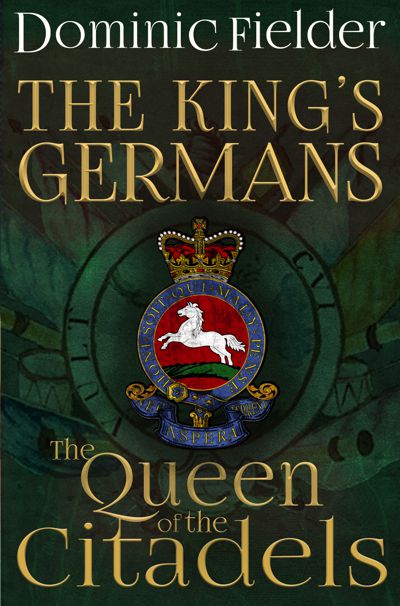
October 1793: The French border.
Dunkirk was a disaster for the Duke of York’s army. The French, sensing victory before the winter, launch attacks along the length of the border. Menen is captured and the French now hold the whip hand. Nieuport and Ostend are threatened, and Sebastian Krombach finds himself involved in a desperate plan to stop the Black Lions as they spearhead the French advance. Werner Brandt and the men of 2nd Battalion race to Menen to counterattack and rescue Erich von Bomm and the Grenadiers, whilst von Bomm struggles to save himself from his infatuation with a mysterious French vivandière.
Meanwhile, dark and brooding, the citadel of Lille dominates the border. The Queen of the Citadels has never been captured by force. The allies must now keep Menen, which guards Flanders, and seize Lille to open the road to Paris. All of this must be done under the watchful eyes of a spy in the Austrian camp. Juliette of Marboré is fighting her own secret war to free Julian Beauvais, languishing in the Conciergerie prison, and waiting for his appointment with the guillotine, as the Terror rages in Paris.

The King’s Germans – the story behind the stories.
I don’t think I’m a fatalist. If you have ever written a story, whatever the length, and walked away from it one evening, only to start again the next day, or week, or a month later, is the story the same as the one that you would have created if you hadn’t stopped at all?
I believe we get to the story that we are meant to tell, eventually.
That was the case with the King’s Germans series. It was a story that I had not intended to write. The scale of it was too ‘grand’; the period unknown to me.
What I had hoped or expected to write was a single story, ‘The Black Brunswickers’. And maybe, one day, I will. The problem is that their story was set at the end of the period know as the Napoleonic Wars.
Why start at the end? It made more sense to start at the beginning.
And that’s when the research rabbit holes opened up. Again, if you have written or researched a story or historical document, it’s those side avenues that come out and swipe you, when you least expect them.
In trying to find something more to tell in the case of the Black Brunswicks, I came across an article on ‘Hanoverian Creams’, a breed of horse that become extinct during the Second World War but had once been the horse of choice for George III.
And there it was. The story that I was meant to write and will write one day. Bear with me on this, it will make sense, I promise.
You see, the Hanoverian Creams became a bone of contention for the Royal household. Between 1804 and 1818, they were not used to pull the royal carriages. Black heavy horses were used instead. Why, you may ask?
Well, the answer to that is painfully simple: Napoleon.
In 1803, French forces overran the state of Hanover. The royal stud at Celle in Hanover was the location where each generation of ‘Creams’ were born and raised until they were needed. Now, someone had the foresight to remove a significant amount of the breeding stock to England before the French invasion of Hanover. However, enough of the horses remained for them to be gifted to Napoleon by one of his generals, and when Napoleon declared himself Emperor of France in 1804, it was King George’s Hanoverian Creams that pulled Napoleon’s carriage. This was the insult that the monarch could not bear, hence the change to black horses for a number of years.
And in this is the kernel of a story, but this was the next problem. I wanted the soldiers involved in this story, the attempt to free the horses on the Celle stud and the events afterwards, to be familiar to readers, to have their own history.
And then it struck me, a little like that scene in Raiders of the Lost Ark, where Indiana Jones and Sallah realise that Belloq is digging in the wrong place. I was starting the story in the wrong place. The story of the Hanoverian Creams will one day be told but it’s now book five in a series of twenty or so books. The first four would tell the story of the war before Napoleon’s name was known to the world.
And then I faced other challenges.
I wanted to tell these stories in a different style. I didn’t want the enemy to just be pantomime villains. What would happen if we knew their story too and we began to care a little (or a lot) about them. How would that make the reader feel when the inevitable crossing of paths occurred.
Then there was the name of the series. Having a strong identifiable character is a bonus but you are signalling to the reader that, no matter how much jeopardy the author places them in, somehow, they will escape. By making the title focus on the King’s Germans, I’m hoping to be opaque. The tales are based around one battalion at first, and the internecine war occurring within it. The ‘heroic leads’ Sebastian Krombach, Erich von Bomm and Werner Brandt, all have their challenges, and failings and their stories will interweave across the two years that the first four books will cover.
But you may also find yourself drawn to the stories of the unlikely lovers, Julien Beauvais and Juliette, Countess of Marboré; of the political machinations of Serge Genet; the friendship between British engineer Stephen Trevethan and Commissary General Jackson or the soldiers of 2nd Battalion, Reifener, Tomas and Henry Pinsk, or the brutal Sergeant Gauner.
It’s a big story! An epic, I hope. Somewhere along the way, at my parent’s market book stall, I must have read one too many Michener or Clavell types – always the size telephone directories when that phrase meant something.
So I believe that I’m writing the stories I was meant to tell. I just hope that someone might find them… and find them interesting to read.
If I achieve that, it will be validation enough.
I can’t say who of my characters will live or die. I have an idea on that front but sometimes, you just end up telling the story that you were meant to tell. All I do know is that it’s a long road from Flanders to Waterloo, and the King will have need of his Germans.
Available on Kindle Unlimited.
Amazon UK: https://www.amazon.co.uk/dp/B08X3SS947
Amazon US: https://www.amazon.com/dp/B08X3SS947
Amazon CA: https://www.amazon.ca/dp/B08X3SS947
Amazon AU: https://www.amazon.com.au/dp/B08X3SS947
Meet Dominic Fielder
Dominic Fielder has had careers in retail and the private education sector and is currently working as a secondary school Maths teacher. He has a First-class honours degree in history and a lifetime’s interest in the hobby of wargaming. The King’s Germans series is a project that grew out of this passion He currently juggles writing and research around a crowded work and family life.
Whilst self-published he is very grateful for an excellent support team. The Black Lions of Flanders (set in 1793) is the first in the King’s Germans’ series, which will follow an array of characters through to the final book in Waterloo. He lives just outside of Tavistock on the edge of Dartmoor. where he enjoys walking on the moors and the occasional horse-riding excursion as both writing inspiration and relaxation.
Connect with Dominic
Twitter: https://twitter.com/Kings_Germans
Facebook: https://www.facebook.com/KingsGermans
Instagram: https://www.instagram.com/kingsgermans/?hl=en
Amazon Author Page: https://www.amazon.co.uk/Dominic-Fielder/e/B07HMB9W2Z
Goodreads: http://www.goodreads.com/book/show/58128682-the-queen-of-the-citadels